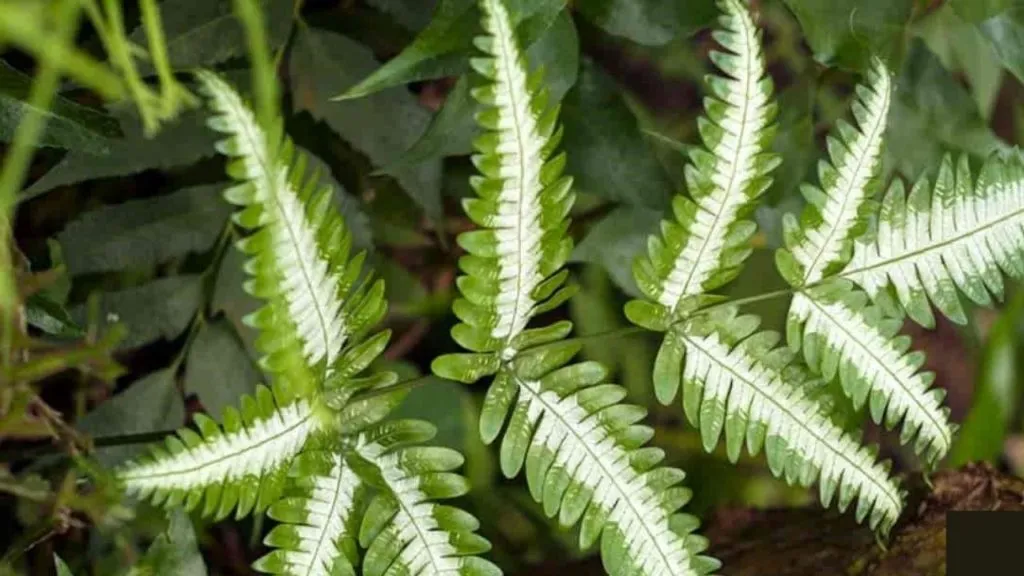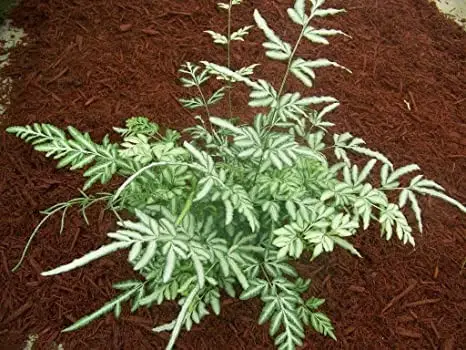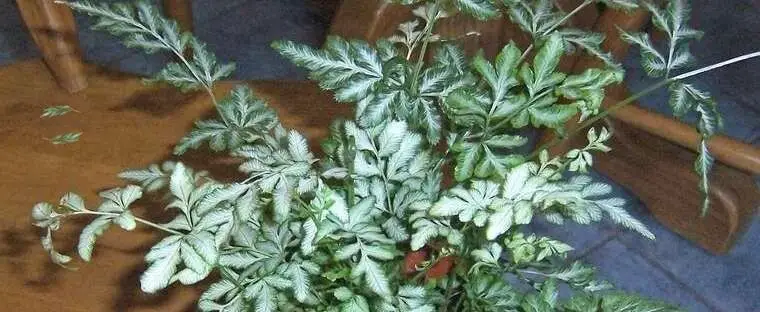Silver lace fern is also known as Pteris ensiform and is one of the vibrant and mesmerizing flora to introduce in your garden bed. The bright colors of the plant are appealing enough to capture your attention and to improvise your garden. It helps in adding life to your previously existing garden, and the plant requires low care requirements.
The native area of silver lace fern is China and Southeast Asia, including tropical and sub-tropical regions. The plant has a compound shape, including linear sori.
If you are also willing to introduce this fantastic silver lace fern at your place, follow the guide below. This guide will help you with proper care and the growth of the plant.
Common Names of the Plant:
- Silver lace fern
- Slender brake fern
- Sword brake fern
- Variegated brake fern

Key Characteristics of the Silver Lace Fern
| Scientific name | Pteris Ensiformis ‘Evergemiensis’ |
| Family | Pteridaceae |
| Genus | Pteris |
| Habitat | Tropical and subtropical |
| pH range | 5.6 to 7.0 |
| Height of the plant | 12 to 16 inches |
| Temperature | 60 to 75 degrees Fahrenheit |
| Humidity | 60% to 90% |
Some interesting facts about the Silver Lace Fern
The plant is aesthetically pleasing, and the splashes of white color on it attract the viewers’ attention, and it loves to thrive in the shady and moist areas.
Here are some interesting facts about this fantabulous plant:
- Different names of the plant reflect additional features and present a distinctive look.
- Both the silver lace and variegated have multiple pleasing shades of white. It exhibits an attractive side of the plant.
- A striking appearance will help you quickly identify the plant.
- It has a multicolored arrangement of ferns.
- The average length of the leaves of silver lace is six inches.
- The root system of the silver lace plant is in the form of rhizomes.
1. Vivarium type:
This silver lace fern houseplant is different from other varieties of the fern. You must place the plant in a habitat with larger space to promote health and fast growth of the plant.
Aquatic features of the plant also contribute to the healthy development of the plant, and you need to uphold the healthy territory,
Here are the aquatic features of the plant for different ferns:
- Paludariums:
Half aquatic condition of the plant will help here to let the plant grow well.
- Terrariums:
Little to no aquatic conditions will help to promote the sustainable growth of the fern.
2. Growth rate:
The growth rate of silver lace fern ranges from medium to the fast level of growth.
3. Preferrable Habitat:
The plant loves to grow in damp, subtropical, and humid tropical environments. It is a hardy plant, and the average temperature of the plant is 60 to 75 degrees.
This will prefer sustainable and fast growth. The plant’s growth depends on the shape provided, and you need to keep it away from direct sunlight.

Check String of Hearts Plant: Complete Care & Growing Guide
4. Idea light requirements of the Plant:
Grow in a tropical environment of bright light. Other than this, the low areas have plenty of canopy of taller trees. The shade provided by these trees helps in better growth and development.
Moreover, you must not place your plant near the window with direct contact with the sunlight. Excessive light can damage the growth of the entire plant. So, you need to maintain the light conditions with the right amount of UK lighting for fern plant care.
5. Substrate Preference:
Nutrient-rich substrate helps in promoting the ideal growth of the plant. You need to retain both the moisture and the drainage level of this plant to help it grow well.
The practical options for the substrate mixture are as follows:
- Coconut coir
- An organic mix containing bark
- Earthworm castings
- Sphagnum moss
6. The toxicity level of the Plant:
If you have kids and pets at your place, then it is the perfect choice of yours. The silver lace fern is non-toxic. But try to avoid ingestion of these leaves by your babies to avert any health issues.
7. pH Preferences:
The preferable condition to help the plant survive includes a lower pH water stage and is more alkaline tolerant.
You must keep the pH level of the plant between 6.0 and 7.0. It can also tolerate neutral pH conditions. So, you must consider this level of pH if you decide to grow this amazingly aesthetic plant.
Uses of the silver lace fern
- The plant is used for ornamental purposes due to its appealing aesthetics. You can cultivate it both indoor and outdoor.
- Taiwan uses this plant as a critical ingredient in traditional drinks.

You May you Like: Mint Leaves Turning Yellow? Check the Reason & Solution
Silver Lace Fern Care and Growth
Here are some of the tactics, which will help you care and grow:
1. Water Requirements:
Here comes the best thing that can help your plant grow appropriately. The suitable amount of moisture within the soil is approximately 70%. Ensure that the soil is not soggy, and you must water the soil till water comes out from the drainage holes.
You can promote the growth of the plant by maintaining a constant amount of moisture. Also, if you are using a fogger, you must place the plant with high humidity with additional watering.
You must avoid overwatering the plant because it results in root rot and bacterial and viral attack.
2. Soil Condition:
The pH of the soil must be in a range of 5.6 to 7, and it will do best in the perfect growth of the plant.
Do you want to let your plant grow best? Make sure to maintain a balanced pH level. Using the mixture of perlite and peat-based soil will also help.
3. Humidity:
Grow in areas with high humidity. The percentage humidity for the ideal growth and care of these plants ranges from 70 to 80%.
If your plant is going through dry weather, then you must use frequent mild misting. Placing a humidifier in a plant will also help you get out of the weather’s arid conditions.
4. Pruning Preferences:
Silver lace fern grows fast and hence can come out of the container. So, you need to cut down or pinch the branches of the plant. It is a highly beneficial technique for silver lace fern care, as it will help maintain the size and growth.
5. Growth zone:
Belongs to the USDA hardiness zone from 9A to 11. In comparison, the sunset zones are 17, 23, and 24.
6. Propagation of the Silver Lace Fern:
It is possible by two methods, described as follows:
- The dispersal of the spores is the critical way of propagation.
- The variegated fern also propagates by the division of rhizome. In this case, you need to maintain the optimum growing conditions of the plant.
Method for Silver Lace Fern Growth:
- Silver lace fern prefers to grow in the wild by using the spore method to produce new colonies. The new stims that emerge from the soil are the baby plants that grow by the spore propagation method.
- You can divide the rhizome as well for the ideal growth of your plant. The ability of the plant to regrow will help you to grow it quickly.
- The successful propagation of the plant is also highly beneficial to replant the fern generously in a new location.
Pro tip:
If you are propagating the plant using the rhizome method, you must not over-bury the rhizome. It will not let the plant grow. Keep the rhizome on the top half of the ball (above the soil). Using this strategy will highly help you in successful growth and propagation.
Also Check: 18 Best Fast Growing Indoor Plants ( FAQs + Pics )
Final thoughts:
Silver lace fern is one of the highly appealing plants for ornamental purposes. The dark green narrow fronds of the fern are enough to attract the attention of the viewers.
One of the most amazing things about these plants is the silver variegated areas and the ruffled margins.
If you are also deciding to introduce this plant in your garden bed, you must provide the plant with successful watering, indirect sunlight, and a moist warm place.
Moreover, you can use multiple methods for the successful propagation of the plant. The plan is non-toxic, and you can grow it in various attractive hanging baskets.
Frequently Asked Questions about Silver Lace Fern
Is silver lace fern an indoor plant?
Silver lace fern is for indoor and outdoor purposes. In indoor, the plant helps for ornamental purposes, and the dark green narrow fronds are enough to capture your attention.
How big does a silver lace fern get?
The average height of the silver lace fern reaches 16 inches with a width of 18 inches. Silver lace fern grows by using the spore propagation method, but the growth of the new clusters of stem will also help the plant grow.
Is silver lace fern toxic to cats?
Silver lace fern is non-toxic, but if you are growing Asparagus fern in your garden, then it is toxic for both dogs and cats. In case if your pet ingests the plant, then it can result in diarrhea and abdominal pain.
How to care for Pteris silver lace fern?
You need to maintain the growing conditions of the silver lace fern care. The plant loves to grow in medium to bright light, and you need to avoid direct sunlight. Also, make sure you water the soil when it’s 25% dry, and continue watering till the water drain out from the pot.
Is silver lace fern drought tolerant?
The plant is drought tolerant and is resistant to both pests and diseases.
